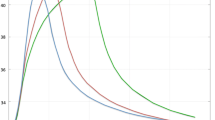Abstract
The influence of the rate of stimulus temperature rise on the interthreshold interval of the appearance of thermal sensitivity of the skin was studied in 14 male volunteers using the MarStock method. The maximal skin thermal sensitivity was shown to occur at the optimum rate of stimulus increase equal to 0.2°C/s, while an increase in the interthreshold interval at other rates of stimuli predominantly occurs due to the increase in the temperature thresholds of the appearance of warmth sensations. A rapid reaction of the acquisition of a new temperature sensitivity level with a sharp change in the rate of stimulus increase was revealed. A critical view was taken of the increased (up to 1 to 3°C) rate of thermal stimulus presentation used in clinical practice. The physiological mechanisms underlying the regularities obtained are discussed on the basis of known data.
Similar content being viewed by others
REFERENCES
Verdugo, R. and Ochoa, J.L., Quantitative Somatosensory Thermotest. A Key Method for Functional Evaluation of Small-Calibre Afferents Channels, Brain, 1992, vol. 115, part 3, p. 893.
Yarnitsky, D., Quantitative Sensory Testing, Muscle Nerve, 1997, vol. 20, p. 198.
Zaslansky, R. and Yarnitsky, D.,Clinical Applications of Quantitative Sensory Testing (QST), J. Neurol. Sci., 1998, vol. 153, p. 215.
Kenshalo, D.R., Decker, T., and Hamilton, A., Comparisons of Spatial Summation on Forehead, Forearm, and Back Produced by Radiant and Conducted Heat, J. Comp. Physiol. Psychol., 1967, vol. 63, p. 510.
Berg. S.L., Magnitude Estimates of Spatial Summation for Conducted Cool Stimuli along with Thermal Fractionation and a Case of Secondary Hyperalgesia, Doctoral Dissertation, Florida State University, 1978 (Kenshalo, D.R., Cutaneous Temperature Sensitivity, in Foundations of Sensory Science, Dawson, W.W. and Enoch, J.M., Eds., Berlin-Heidelberg-New York-Tokyo: Springer-Verlag, 1984).
Kenshalo, D.R., Holmes, C.E., and Wood, P.B., Warm and Cool Thresholds as a Function of Rate of Stimulus Temperature Change,Percept. Psychophys., 1968, vol. 3, p. 81.
Davies, S.N., Goldsmith, G.E., Hellon, R.F., and Mithchell, D., Facial Sensitivity to Rates of Temperature Change: Neurophysiological and Psychophysiological Evidence from Cats and Humans, J. Physiol. (Lond.), 1983, vol. 344, p. 161.
Kenshalo, D.R., Cutaneous Temperature Sensitivity, in Foundations of Sensory Science, Dawson, W.W. and Enoch, J.M., Eds., Berlin-Heidelberg-New York-Tokyo: Springer-Verlag, 1984.
Ruffel, C.M. and Griffin, M.J., Effect of Starting Temperature on the Repeatability of Thermotactile Thresholds, Cent. Rur. J. Public Health, 1995, vol. 3, suppl. 81.
Divert, V.E., Body Thermal State Influence on Local Skin Thermal sensitivity, Int. J. Circumpolar Health, 2001, vol. 60, p. 305.
Ohnishi, A., Yamamoto, T., Murai, Y., and Ikeda, M., Cutaneous Thermal Cooling and Warming Detection Thresholds in Distal Extremities of Normal Subjects, J. UOEN (Univ. Occup. Envir. Health, Japan), 1992, vol. 14, no. 3, p. 235.
Kenshalo, R., Correlations of Temperature Sensation and Neural Activity: A Second Approximation, in Thermoreception and Thermoreguglation, Bligh, J. and Voigt, K., Eds., 1990.
Borovikov, V.P. and Borovikov, I.P., STATISTICA-statisticheskii analiz i obrabotka dannykh v srede Windows (STATISTICA is a Statistical Analysis and Data Processing in the Windows Medium), Moscow: Inf.-Izd. Dom Filin, 1998.
Hering, E., Grundzuge einiger Theorie des Temperatursinns, Sitzber. Wien Akad., 1877, vol. 75, no. 3, p. 101.
Kenshalo, D.R. and Scott, H.H., Temporal Course of Thermal Adaptation, Science, 1966, 1977, vol. 151, p. 1095.
Iggo, A., Cutaneous Thermoreceptors in Primates and Subprimates, J. Physiol. (Lond.), 1969, vol. 200, p. 403.
Konstantinov, V.A., Danilova, N.K., and Ivanov, K.P., Effects of Temperature in Different Skin Layers on the Spike Activity of Cold Thermorecepotrs, Fiziol. Zh. SSSR, 1980, vol. 66, no. 6, p. 902.
Konstantinov, V.A., Danilova, N.K., and Ivanov, K.P., Localization of Cold Themoreceptors in Different Skin Layers, Fiziol. Zh. SSSR, 1983, vol. 69, no. 2, p. 204.
Ivanov, K.P., Subject of Temperature Control and the Main Function of Thermoregulation of an Organism, J. Thermal Biol., 1999, vol. 24, p. 415.
Baevskii, R.M., Kirillov, O.I., and Kletskin, S.Z., Matematicheskii analiz izmenenii serdechnogo ritma pri Stresse (Mathematical Analysis of Heart Rhythm Changes in Stress), Moscow: Nauka, 1984.
Fleishman, A.N., Medlennye kolebaniya gemodinamiki (teoriya, prakticheskoe primenenie v klinicheskoi meditsine i profilaktike) (Slow Fluctuations in Hemodynamics (Theory, Practical Use in Clinical Medicine and Prophylaxis), Novosibirsk: Nauka, 1999.
Burton, A.C., The Range and Variability of Blood Flow in the Human Fingers and the Vasomotor Regulation of Body Temperature, Am. J. Physiol., 1939, vol. 127, p. 437.
Hyndman, B.W., Kitney, R.I., Sayers, B.Mc.A., Spontaneous Rhythms in Physiological Control Systems, Nature, 1974, vol. 223, p. 339.
Lindqvist, A., Jalonen, J., Parviainen, P, et al., Effect of Posture on Spontaneous and Thermally Stimulated Cardiovascular Oscillations, Cardiovasc. Res., 1990, vol. 24, no. 5, p. 373.
Minut-Sorokhtina, O.P., Fiziologiya termoretseptsii (Physiology of Thermoreception), Moscow: Meditsina, 1972.
Munch, P.A., Flow and Thermal Responses of Aortic Baroreceptors, J. Neurophysiol., 1993, vol. 70, no. 6, p. 2596.
Braverman, I.M., The Cutaneous Microcirculation: Ultrastructure and Microanatomical Organization (Review), Microcirculation, 1997, vol. 4, no. 4, p. 329.
Glebova, N.F., The Involvement of Venous Thermoreceptors in Chemical Thermoregulation, Dokl. Akad. Nauk SSSR, 1963, vol. 149, no. 3, p. 742.
Author information
Authors and Affiliations
Rights and permissions
About this article
Cite this article
Divert, V.E. The Influence of the Rate of Stimulus Temperature Rise on Local Skin Thermal Thresholds. Human Physiology 28, 575–580 (2002). https://doi.org/10.1023/A:1020230902910
Issue Date:
DOI: https://doi.org/10.1023/A:1020230902910




